
Discover more at Cliveden
Find out when Cliveden is open, how to get here, the things to see and do and more.

Follow in the footsteps of dukes, earls, kings and queens as you stroll through a series of impressive spaces at Cliveden, each with its own special charm. Enjoy year-round interest and colour, from the bedding scheme of the Parterre and the hundreds of roses in the Rose Garden, to Lord Astor’s sculpture collection and the impressive Cliveden Maze. Cliveden is famous for its formal flower displays in the summer, particularly on the grand Parterre, in the Duke’s Garden and on the Lower Terrace. This year, the Parterre will be awash with a dazzling display of white, purple and orange. The sixteen main Parterre beds are being planted up with a mixed display of Salvia ‘Victoria Blue’ and Gazania rigens ‘New Day Clear Orange’. Each bed will also be interlaced with a ribbon of Senecio cineraria ‘Silver Dust’ as we give a nod to the original bedding scheme designs of John Fleming, Head Gardener at Cliveden in the 1850s.
There is an abundance of colour, interest and scent at Cliveden during the colder months of winter that are ideal for walkers of all abilities.
Head to the Japanese-inspired Water Garden for a range of highlights including the bark on our Himalayan Birch (Betula utilis var. jacquemontii) and our cluster of Acer griseum, to the abundant red berries on our Cotoneaster x watereri. Look out for a bright yellow carpet of winter aconites (Eranthis hyemalis) underneath the birches, and make sure to take a wander along Dog Walkers' Path to see the newly renovated cascade waterfall with its surrounding planting of acers, ferns and bamboo.
Staying in the Water Garden, visitors will also be able to experience some fabulous fragrances that linger in the air from shrubs such as Sarcococca confusa, Chimonanthus praecox, Daphne bholua ‘Jacqueline Postill’ and D. 'Garden House Ghost'. Close to the path edge in this area of the estate you can spot Helleborus x hybridus ‘White Lady’ which is the first of our hellebores to bloom, closely followed by pink and lilac varieties. Towards the end of the year, the vivid yellow sprays and scent of flowering mahonia also really catch the eye and cheer the soul on a dark winter's afternoon.
Elsewhere at Cliveden, the Long Garden’s topiary will be freshly cut creating a sculptural effect throughout the garden and you may catch flashes of purple berries on the shrub border that belong to what is commonly referred to as the beautyberry (Callicarpa bodinieri var. giraldi ‘Profusion’) along with the coloured stems of Cornus ‘Midwinter Fire’. This year, the Long Garden's new perennial planting scheme will be left to provide structure and seedhead interest throughout the winter months, as well as providing habitat and food sources for wildlife. You will also be able to see a variety of interesting seedheads and silhouettes on the two large herbaceous borders in front of the house as they die back after providing a riot of colour through the summer.
There are also several varieties of snowdrops and cyclamen dotted around the estate, with particularly fragrant and bright groups in front of the Rose Garden entrance and all around the Water Garden. Many walkers will also enjoy heading past the Blenheim Pavilion and down through the hanging gardens, where the bare stems of winter and further groups of snowdrops provide a very different feel to the colour and scent in the Water Garden and Long Garden.
At the end of a bracing walk, you may also enjoy our seasonal display of colourful Heuchera by the Conservatory Cafe - the perfect way to end a visit to Cliveden on a winter's day.
The access route map is available from the Information Centre.
Head to the picnic area opposite the Walled Garden, there are picnic benches / tables at the back of the Water Garden, by the river and at the Woodland lounge.
Benches are located throughout the route around the formal gardens.
Paths around the formal gardens are laid to hard standing paths with a loose gravel top. Upon leaving the level access route, the Cliveden’s site is undulating with steep slopes in places and many steps (particularly when visiting Cliveden Riverside).
Blenheim Pavilion, the Rose Garden, the Round Garden and the War Memorial Garden.
Two manual wheelchairs (including off road) and two all-terrain trikes (non-powered) are available from the Information Centre. We recommend hiring in advance of your visit. Please email cliveden@nationaltrust.org.uk or call 01628 605069 to book. Two sturdy pushchairs are available at the Information Centre. Pre-booking is available but not essential.
Restoration work on Cliveden’s Long Garden is now complete, with the garden reopened to visitors. The aim of this restoration was to create a more sustainable planting scheme designed by James Scott, FSGLD, MBALI, MD and Principal Designer of The Garden Company. James’s design pays homage to Norah Lindsay’s original early 20th-century designs. Situated along the north boundary of the Cliveden estate, parallel with Bourne End Road, the Long Garden has been updated to reflect both its historic roots and modern ecological considerations.
This project involved numerous significant updates. Firstly, the central path has been replaced with a durable York stone paving which has a smooth, even surface, making it more welcoming and accessible for visitors. As a part of this drive for greater accessibility automated entrance gates have also been installed at either end of the garden. The old box hedging has also been removed and replanted with a more resilient yew hedge. Once the path had been laid and the hedge planted, the four central beds were replanted and over the last few months the planting has quickly established, creating a dazzling display of vibrant colour, form, and texture.
The apple trees trained around the arched structures of the Round Garden are heavy with fruit in the autumn. It's worth a wander through the apple 'tunnels'. The restoration of the garden at Cliveden has revealed many secrets, including a long-lost fruit garden on the northern edge of the woodlands, just a short walk from Green Drive. The Round Garden was laid out in the mid-19th century and is possibly the only surviving example in the UK of a circular fruit orchard from this period.
Having been out of production since the 1950s, it has been brought back to life by the ranger team who are protecting heritage trees and planting many new ones. Wildlife flourished while it was out of action, making it a haven for rare insects and fungi, as well as bats and birds.
The recent new planting schemes in the Water Garden are really starting to mature now, offering an array of both colour and scent from spring all the way through to the winter months. The Acers, Tai Haku (Great White Cherry) and a Wedding Cake Tree in our new project bed on the right hand side as one enters the Water Garden gave beautiful blossom in the spring. King George rhododendrons, one of the best hybrid rhododendrons with soft pink flower buds that open to pure white and give off a lovely fragrance, are planted at either end of the same bed and provide a wonderful sight. Along the back of the bed are spreading hydrangeas with lilac blue flowers to provide a beautiful backdrop.
Elsewhere in the Water Garden, the pond renovation scheme completed in Summer 2024. The ponds were built in the late 1890's and the concrete that lined them was cracking, allowing water to escape. Now that the repairs have been completed, we will be saving gallons of water every year.
The carp are very happy to be back in their new home and we look forward to seeing how our new aquatic planting scheme of waterlilies, marsh marigolds, iris and myosotis establishes over the coming years’. The Water Garden may take some time to settle after the disruption, but the de-silted, cleaner ponds means that the waterlilies and fish will have more space to thrive.
Situated in front of the house are two large, double-width herbaceous borders that provide a dazzling display of colour in the summer months. Based upon designs made in the 1960s by Graham Stuart Thomas, the noted horticulturalist and former Gardens Consultant to the National Trust, these visitor favourites feature one hot border filled with tones of red, yellow and orange while the cool border (running alongside the Clock Tower lawn) contains tones of blue, white and purple. The displays are so full that you can spot something new each time you visit, with dahlias, thalictrum, salvias, penstemons and asters drawing particular attention at the height of the season.
In 2024, the garden team changed the bedding by taking more than 12,000 wallflowers, tulips and hyacinths from the Parterre, and replaced these with a striking combination of red and white begonias, interlaced with ribbons of red salvias and white antirrhinums. With red and white geraniums in the Parterre’s yew obelisk beds, it promises to be a vivic display.
In the Parterre’s large semi-circle bed, we will be planting chlorophytum – the spider plant – as a border to a bold display of almost 6,000 red Beacon Impatiens (Busy Lizzies), and the bedding in the Duke’s Garden in 2024 will also be a must-see – around 2,000 Osteospermum Voltage Yellow dotted throughout with Canna Cannova Bronze Scarlet. It should be an electric combination.
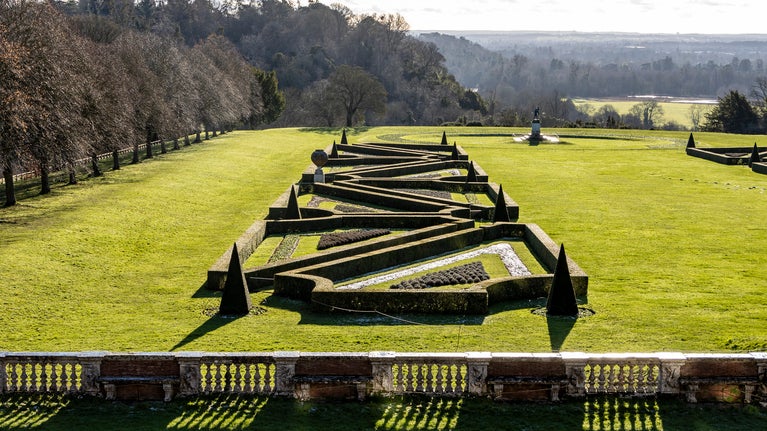
Cliveden’s Rose Garden – originally designed by Sir Geoffrey Jellicoe for the 3rd Lord Astor in the 1950s – is a unique take on an ‘Edwardian style’ rose garden. With around 850 roses – including shrubs, floribunda, hybrid teas and climbers – the garden provides a wonderful array of colour from June all the way through to the autumn months.
In 2024, will see the first flowering of the 70 new rose plants that we planted in November 2023, when we excavated and replaced over 20 tonnes of soil. Jellicoe’s scheme has a dramatic colour combination, sweeping from yellow in the east through amber and orange to red in the west and we think the five new varieties that we have introduced – Sir John Betjeman, Sophy’s Rose, Dannahue, Bring Me Sunshine and Roald Dahl – will make a bold addition to the garden’s established design.
At the same time, we have this year introduced a selective range of underplanting in some of the rose beds. With alliums, comfrey, nepeta and Lady’s Mantle, we will be extending the season of interest and – we hope – improving soil health and attracting a more diverse range of pollinators as well.
Did you know the main visitor car park was originally a walled garden created to supply the estate with fruit and vegetables? We've been working to reinstate the kitchen garden’s character by planting fruit trees against the walls.
From spring to autumn the Walled Garden provides produce for the estate to use, from lettuce to plums. There is a walk around the perimeter of the main car park for you to get up close to see what we’re growing.
Cliveden provided the Canadian Red Cross with a hospital during the First World War. In 1918, the 1st Viscount Astor's sunken Italian garden was adapted to create a memorial garden for the deceased. It contains 42 war graves from the First World War, each marked with a stone set in the turf.
If you are planning to make a special trip solely to visit the war graves, please email or call us in advance on 01628 605069. If you would like to incorporate a visit to the War Memorial Garden while exploring the wider estate, please note usual admission charges apply.
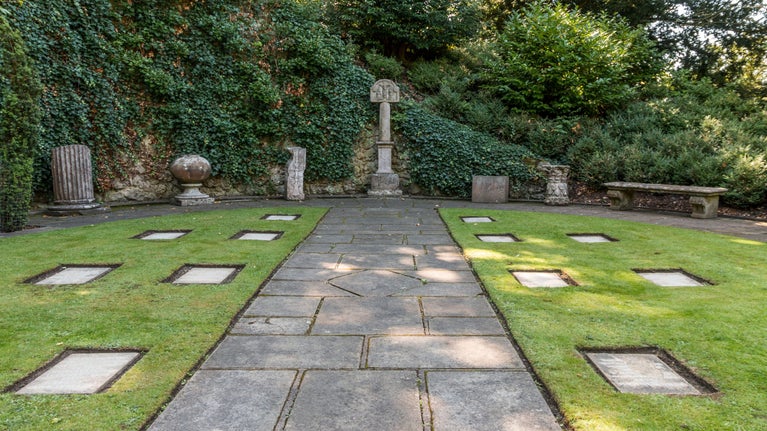
We'd love for you to cycle to Cliveden and you can lock bikes up in the spaces provided in the Walled Garden. 5 year olds and under are able to bring small scooters and balance bikes onto the estate. Mobility scooters can also be taken onto the estate but please leave bikes with pedals by the Information Centre.

Find out when Cliveden is open, how to get here, the things to see and do and more.
Cliveden has many sculptures in its grounds, including ancient baboons and bold choices of ‘new art’ sculpture from Cliveden’s 19th-century owners.
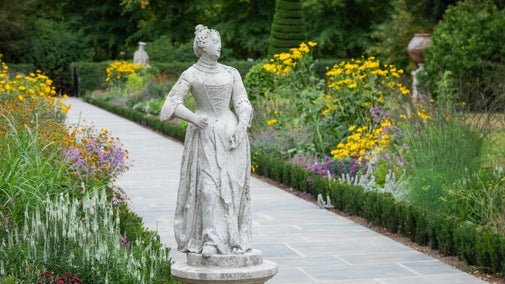
Discover majestic trees, tranquil glades and far-reaching views as well as some unusual features in Cliveden’s woodlands, including a flint grotto and part of a giant sequoia tree.
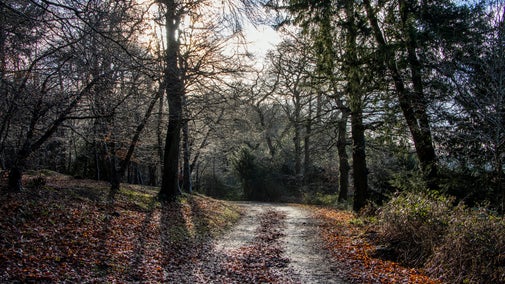
Restoration work on Cliveden’s Long Garden is now complete, with the garden reopened to visitors. The aim of this restoration was to create a more sustainable planting scheme designed by James Scott, FSGLD, MBALI, MD and Principal Designer of The Garden Company. James’s design pays homage to Norah Lindsay’s original early 20th-century designs. Situated along the north boundary of the Cliveden estate, parallel with Bourne End Road, the Long Garden has been updated to reflect both its historic roots and modern ecological considerations.
Cliveden is a two pawprint rated place. Dogs are welcome across many areas, with woodlands, riverbank and a formal garden all offering a variety of dog-friendly walks.
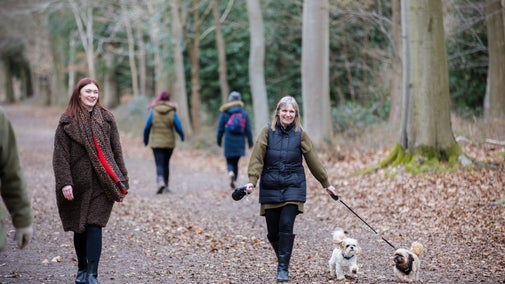
If you’re looking to get the whole family outside this winter look no further.
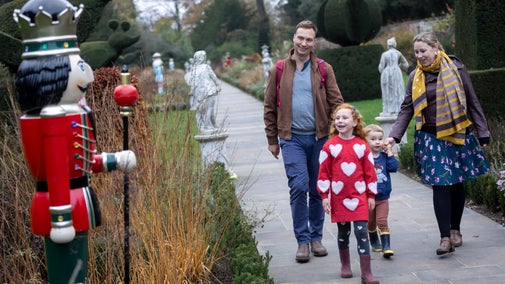
From 18th-century water gardens and Arts and Crafts landscapes to intimate woodland gardens, there are so many places to discover.

Discover our gardeners’ top tips so you can make the most of your garden, plot or window box.
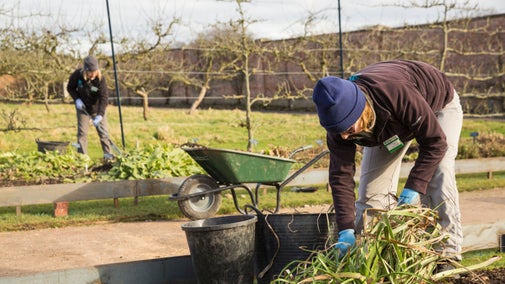
Gardens from the grand scale of Stowe's landscape garden to formal parterres at Hughenden and Cliveden and the intimate walled garden 'rooms' at Greys Court.
